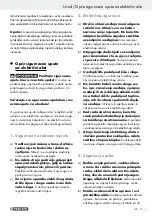
8 GB
General power tool safety warnings / Preparing for use
General power tool safety warnings
wrench or a key left attached to a rotating part
of the power tool may result in personal injury.
e)
Do not overreach. Keep proper foot-
ing and balance at all times.
This enables
better control of the power tool in unexpected
situations.
f)
Dress properly. Do not wear loose
clothing or jewellery. Keep your hair,
clothing and gloves away from mov-
ing parts.
Loose clothes, jewellery or long
hair can be caught in moving parts.
g)
If devices are provided for the connec-
tion of dust extraction and collection
facilities, ensure these are connected
and properly used.
Use of dust collection
can reduce dust-related hazards.
4. Power tool use and care
a)
Do not force the power tool. Use the
correct power tool for your application.
The correct power tool will do the job better
and safer at the rate for which it was designed.
b)
Do not use the power tool if the switch
does not turn it on and off.
Any power
tool that cannot be controlled with the switch is
dangerous and must be repaired.
c)
Disconnect the plug from the power
source and / or the battery pack from
the power tool before making any ad-
justments, changing accessories, or
storing power tools.
Such preventive safety
measures reduce the risk of starting the power
tool accidentally.
d)
Store idle power tools out of the reach
of children and do not allow persons
unfamiliar with the power tool or these
instructions to operate the power tool.
Power tools are dangerous in the hands of un-
trained users.
e)
Maintain power tools. Check for mis-
alignment or binding of moving parts,
breakage of parts and any other con-
dition that may affect the power tool’s
operation. If damaged, have the power
tool repaired before use.
Many accidents
are caused by poorly maintained power tools.
f)
Keep cutting tools sharp and clean.
Properly maintained cutting tools with sharp
cutting edges are less likely to bind and are
easier to control.
g)
Use the power tool, accessories and
tool bits etc. in accordance with these
instructions, taking into account the
working conditions and the work to
be performed.
Use of the power tool for
operations different from those intended could
result in a hazardous situation
.
5. Service
a)
Have your power tool serviced by a
qualified repair person using only iden-
tical replacement parts.
This will ensure
that the safety of the power tool is maintained.
Q
Safety advice for
belt sanders
Hold the device by the insulated han-
dle surfaces as the sanding belt could
strike the device’s own mains lead.
Damaging a live wire could result in the metal
parts of the device also becoming live and
could lead to an electric shock.
DANGER OF FIRE FROM FLYING SPARKS!
Sanding metal creates flying sparks. For this
reason, always make sure that nobody is placed
in any danger and that there are no inflammable
materials near the working area.
When undertaking prolonged sanding of wood,
and in particular when working on materials
that give rise to dusts that are hazardous to
health, the sander must be connected to a
suitable external dust extraction device.
Ensure that there is adequate ventilation when
working on plastic, paint, varnish etc.
The belt sander is designed for the dry sanding
of large surfaces of wood, plastic, metal and
plaster and painted surfaces. The device is to
be used for dry sanding only.
Do not sand materials containing asbestos.
Asbestos is a known carcinogen.
Summary of Contents for 96798
Page 3: ...A B C D E F 8 12 2 3 4 13 11 1 6 7 5 9 10 ...
Page 4: ......
Page 14: ...14 ...
Page 24: ...24 ...
Page 34: ...34 ...









































